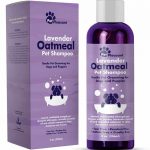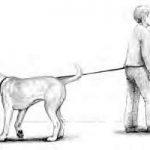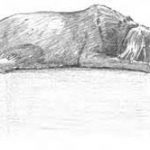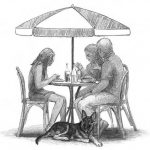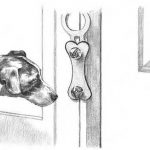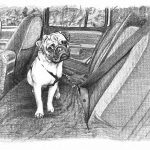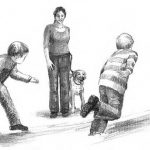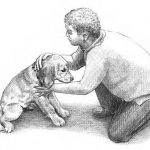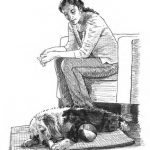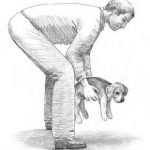Food and Fitness

In This Chapter
On a day-to-day basis, you can do so much — from feeding your puppy an appropriate diet to making sure she’s getting the right exercise — to influence your puppy’s health. A healthy puppy is a happy puppy, which, for you, means less chewing, more cooperation, consistent potty habits, and a calmer attitude overall.
Puppy Nutrition 101: Making Sure Your Pup Is Well-Fed
Warning!
Feeding your puppy the wrong diet affects her health and her behavior. The wrong diet can increase your puppy’s susceptibility to disease, infection, and possibly nervous/aggressive disorders.
Remember
As your puppy ages, she’ll need a different balance of nutrition to keep her healthy. Like humans, older dogs need less protein and fewer calories.
The origins of commercial dog foodBefore World War II, dogs ate human leftovers — a tradition that had endured since the moment the first dog was domesticated from the wolf. With the war came economic strain and a weakened work force, which resulted in the development of commercialized dog food. Animal parts unfit for human consumption, which would otherwise be discarded as waste, were processed as dog food. Yum. The first commercial bags of dog food were sold in the grocery stores. Many of those same first brands can still be found today. In the early ’70s, specialty pet stores were introduced, and with these stores came the study and preparation of higher-quality foods. |
Essential ingredients — and how they differ from brand to brand
Remember
Even though the requirement is set by law, each company can choose whatever ingredients it wants to fill that requirement. For example, some foods include soy to meet the daily protein requirement, while other foods include meat or animal protein. Think of it this way: It’s like the difference between eating ten soy burgers to get my daily requirement of protein versus eating a good, wholesome piece of chicken. Well, perhaps I’m exaggerating, but you catch my drift. For dogs, animal protein beats soy hands down.
– Pick-me-up-anywhere brands: You can find these brand names just about anywhere. A segment on 60 Minutes described how these widely commercialized food companies get their meats: They select from the Grade 4-D categories — meaning those animals that are dead, dying, diseased, or decaying. How’s that for appetizing? In addition, much of the fat in these brands is indigestible, requiring greater amounts to meet daily nutritional requirements.
– Premium labels: Found in specialty pet stores and animal hospitals, premium foods originated to improve the quality control and ingredients offered to pets. A higher grade of meat is used, and the food contains a higher quantity of usable fats.
– Holistic feed: These foods can also be found in specialty pet stores. The word holistic translates into “human-grade everything.” This means the food has human-grade meats, digestible fats, and a grain carbohydrate mix of the highest standard. Many are even hormone- and steroid-free. Even though holistic dog food often costs more and can be challenging to find, it’s calorie-rich, requiring less bulk to meet the daily nutritional requirement. And theoretically, if you got really hungry. . . .
Tip
When searching for the right dog food, pay close attention to your dog’s digestion. Foods with low-quality ingredients aren’t absorbed as well and can give your dog loose stools. A good food should help your puppy produce two to four compact, inoffensive-smelling stools a day.
Proteins (recommended 21 to 26 percent of the food)
Remember
Protein is the source that determines the quality of the dog food. When you read the label, you see one or more protein sources: meat, animal, and grain protein. Here’s the translation:
– Meat protein: Meat protein consists of organ meat or muscle meat. This type of protein is the closest to human quality and is superior to other protein sources.
– Animal protein: Animal protein consists of any part of the animal that contains protein — hair, hoofs, lips, and eyelashes are included in this group.
– Vegetable or grain proteins: Reconsider foods whose ingredient list leads off with soy, meat byproducts, or crude protein (which includes everything crude on the body from hair to nails). First of all, you have to feed a lot of this food to your dog to meet her daily requirement, and of course, what goes in must come out. Second, unusable protein stresses the kidney. Anything that spells out “gluten” can be translated to mean a hard-to-digest, low-quality protein that is inexpensive for the manufacturer to produce.
Some puppies are allergic to grains found in dog food. The most common allergies are to corn, wheat, and soy. Certain grains also may contain fertilizer residue, which can cause an allergic reaction. If your pup refuses to eat her food or her digestion seems abnormal in any way, consult your veterinarian and bring along the labels from your puppy’s food to help the vet identify any possible aggravating ingredients.
Technical Stuff
The crude protein measurement for a puppy food totals all protein obtained from the animal protein source, as well as the protein found in the grains.
– The need for protein changes throughout your puppy’s life. Whenever she experiences a temperature change or any kind of emotional stress, her system will demand a certain amount of protein. When stress occurs, your puppy uses more protein (and therefore relies on you to feed her more protein). If your puppy leads a more sedentary existence or you’ve restricted exercise due to a recommendation or injury, speak to your veterinarian about reducing the ratio of protein in your puppy’s diet.
– Ever wonder what the difference is between active, low-active, lite, puppy, and performance foods? You guessed it: the percentage of protein.
Warning!
– More protein isn’t always better. High-protein diets are used for show or working dogs. If you have a sworn couch potato or a dog who must spend hours alone, feeding her a high-protein diet (which, broken down, equals energy) makes her jittery and hyper.
Carbohydrates (recommended 42 percent of the food)
Tip
If your pup inhales her food, slow her down. Take a large pan, place heavy rocks in the bottom, and add her food to create an eatable obstacle course. Just be sure the rocks are too large to eat.
Fats and preservatives (15 to 20 percent of the food)
Remember
Sources of usable fats include chicken fats, sunflower or canola oil, fish oil, and lactose-free dairy products. I recommend lactose-free dairy products because after a puppy loses her baby teeth, she loses the enzyme needed to process the milk chemical lactose. Even though a dog doesn’t know the difference between lactose and lactose-free, her stomach sure does — lactose in dogs produces gas and loose stool.
– Many food companies have begun adding tallow fat to meet the minimum daily requirement. Used in the production of candles, this fat is inexpensive and indigestible. When a brand claims a “new formula,” make sure the change doesn’t include this unusable ingredient.
– Supplementing fat in your puppy’s diet is often unnecessary. However, if your vet encourages you to increase fat content, use pressed safflower oil drizzled over their meal — approximately 1 teaspoon for small dogs and 1 tablespoon for large dogs. This oil has a high concentration of linoleic acid and is least likely to cause an allergic reaction.
– In commercial puppy foods, check the label to see what preservatives are used. If you’re unsure, speak to your veterinarian or other professional. For example, the preservative ethoxyquin is a recognized carcinogen.
Vitamins (1 percent of the food)
– Fat soluble: These vitamins, which include vitamins A, D, E, and K, are stored in fatty tissue and in the liver.
– Water soluble: These vitamins, which include vitamins B and C, are flushed through the body daily — either used up or excreted.
Technical Stuff
Should you supplement your pup’s diet with vitamin C? Not everyone agrees on the answer to that question. Do an Internet search on “supplementing your dog’s diet” and read the controversy. The arguments for supplementing with vitamin C are these: What’s unused is washed from the dog’s body, and in the best-case scenario, vitamin C can strengthen the elastic tissues, making them more resilient to stress. Although no formal studies prove this, negative effects don’t seem to occur with supplements. However, opponents argue that dogs’ bodies can produce all the vitamin C they need.
WaterDid you know that your dog can live three weeks without food but will die within days without water? Water is necessary for all digestive processes, as well as temperature regulation and nutrient absorption. Water acts as a transportation medium, shipping things between organs and out the body. How much water your pup needs depends on the intensity of her physical activities and the type of food she eats. Panting is your dog’s means of sweating. If your dog is panting, you know she needs a drink. Dry food also encourages thirst. Because dry food contains only 10 percent moisture, your dog needs about a quart of water for every pound of dry food she eats. Canned dog food or home-cooked diets, on the other hand, contain more water (keep in mind, though, that the higher water content doesn’t necessarily make them a superior food source). If you’re using water from the faucet, have it tested (or test it yourself) to ensure it’s free of harmful contaminants. Faucet water has been known to contain bacteria, viruses, lead, gasoline, radioactive gases, and carcinogenic industrial components that can cause chronic health problems. Department stores, such as Wal-Mart, carry inexpensive water testing kits that test hardness and measure chlorine, pH, nitrate, and iron levels. |
Remember
The need for vitamins varies, depending on your puppy and her lifestyle. If you’re considering supplementation, speak with your veterinarian first. Vitamins are a rather unstable lot, easily destroyed by light and heat, so investing in a good vitamin supplement may be a smart decision. Ask your veterinarian for suggestions. If you’re feeding your dog a high-quality diet, supplementation may be unnecessary and maybe even harmful.
Minerals (1 percent of the food)
Warning!
Though mineral deficiencies are more common than vitamin deficiencies, don’t supplement your dog’s diet unless your veterinarian directs you to do so. Adding minerals to your puppy’s diet can cause an imbalance that’s harmful to her health. (To discover more about how specific minerals affect your dog’s health, refer to The Holistic Guide for a Healthy Dog, by Wendy Volhard and Kerry Brown, D.V.M. [Macmillan Publishing].)
Interpreting food labels to get more bang for your buck
Remember
To pick the right food for your dog, you need to figure out how to read ingredient labels. You also have to consider your puppy. Formulas that agree with one puppy don’t necessarily agree with another. As you pay more attention to your puppy’s diet, you’ll discover that the most costly, aggressively marketed, or cleverly labeled food isn’t necessarily the best. Speak with your veterinarian or another professional.
Remember
Feeding your pup a homemade dietYes, you can still feed your dog a human-food diet, but you have to make sure it’s balanced. Followed responsibly, the home diet can be modified for your puppy’s age, breed distinctions, and individual needs. Some dogs, regardless of breed, suffer when they eat commercialized dog foods. The natural homemade diet can solve problems related to this condition. The drawback to feeding your dog naturally is that you must commit yourself to prepare balanced meals and to shop for products regularly to ensure freshness. If you want to try a homemade diet, refer to The Holistic Guide for a Healthy Dog, by Wendy Volhard and Kerry Brown, D.V.M. (Macmillan Publishing). |
Understanding food allergies and special needs
Allergies to your food and theirs
Remember
Your puppy’s system is simply not set up to handle the variation that’s present in our diet. Processed foods are especially problematic because they have chemicals that are neither recognized nor absorbed by her body. If you’re determined to share your plate with your pooch, keep the additions unprocessed. For example, fruits, veggies, or meats are best for your pup.
Warning!
Avoid giving your puppy dairy products. She’s unable to break down the enzymes, which leads to indigestion, diarrhea, and gas — and I mean loads of gas.
Special nutritional situations
Tip
If you have a large-breed puppy who’s prone to growing quickly, don’t be surprised if your breeder or veterinarian suggests feeding her an adult food.
Keeping Your Puppy Fit
Making the activity age-appropriate
Warning!
A puppy’s tissues are soft and her bones are growing. She’s as awkward as an infant trying to take her first step. Not to mention that the stairs frighten her. Even though taking your brand-new companion with you on your 5-mile jog would be nice, it wouldn’t be safe. Too much exercise stresses your puppy’s growing body. Your puppy would get distracted and quit or she might demand to be carried. Sure, you want to keep your puppy in shape — an obese puppy is an unhealthy puppy — but puppies aren’t born ready to run endless miles. You have to let her develop first.
Tip
Play on grass or dirt surfaces. Keep pups off the pavement, except for when they’re going out to potty. Hard pavement is too stressful on their bones and tissues. Tile and linoleum floors are also a real nightmare for puppies because they’re so slippery. Lay carpet strips down on these types of surfaces until your pup gets older.
Don’t just watch — be an exercise companionPuppies don’t like to exercise alone. They need a companion to frolic and play with. Unless you have a couple of dogs, you need to exercise your puppy two to four times a day for 5 to 20 minutes, depending on her age and breed. I know this sounds like a lot of exercise, but after you get into a groove, it’ll feel like recess in the third grade. When you bring a young puppy home, she has five needs: food, water, elimination, sleep, and exercise. Yes, exercise is a need. When it’s time to play, you have no choice: You must get involved. Because a walk down the street can be frightening to a new puppy (because of cars, big dogs, and so on), games (see Chapter Ten Fun Games) are the best way to tire her out. |
Warning!
Avoid games like tug of war, wrestling, chasing, or teasing. These games frustrate pups, communicate confrontation, encourage nipping (especially on clothing), and make you look more like a playmate than a leader.
Factoring in size, breed, and energy level
Table 19-1 | Breeds and Their Energy Levels | |
Breed | Bred To | Energy Level |
Pointers | Course fields all day, point, and retrieve | Very high |
Retrievers | Stay by master’s side and retrieve on command | High |
Spaniels | Flush and retrieve birds | High |
Setters | Run in the fields, point, flush, and retrieve fowl | High |
Sighthounds | Pursue fast-moving game | High in spurts and then low |
Scent hounds | Follow and trail game | High |
Large game hunters | Challenge large game | Medium |
Sled/draft dogs | Pull sleds long distances and pull carts to market | Medium to high |
Guarding | Guard territory | Medium |
Personal protection | Protect home and master | Medium |
Rescue/water dogs | Rescue humans | Low (in general) |
Portuguese Water Dog | Retrieve nets from water | High |
Sheep herders | Herd sheep | Medium to high |
Livestock driving | Move sheep and cattle from field to field | High |
Terriers | Hunt barn pests | Medium to high |
Fighting breeds | Originally bred to fight each other or other species | Medium |
Non-Sporting | All vary historically | Medium |
Dalmatian | Currently bred for companionship | Very high |
Toy Group | Companionship | Low |
Warning!
If your puppy doesn’t work off her energy outside, she’ll work it off inside. Along the same lines, if you don’t run her, she may demolish your couch. No, it’s not spite. It’s just energy coupled with boredom.
Fun and games
Agility
Flyball
Freestyle
Frisbee
1. Treat the disk as a dinner plate.
It looks like one anyway, right? For a week, feed your dog on the disk, picking it up after each meal to prevent chewing. Wash and hide the disk until the next feeding.
2. Practicing inside initially, teach your dog playfully with the disk, saying “Get it.”
Tip
When she grabs the disk, tug lightly to ensure a secure grip before you get her to release it by offering food or tremendous praise.
3. Now play keepaway.
Show your dog the disk and run a short distance before allowing her to grasp it. To see whether your dog is sufficiently in love with the new object, turn it upside down and slide it a short distance away from you on the floor. When your dog grasps it, praise her tremendously. (Initially, your dog probably won’t want to give the disk back to you. That’s okay, though. Worry about the good retrieving skills after you’ve nailed the grab.)
4. Try the keepaway game with a new disk that hasn’t been used as a dinner plate.
Your dog may react differently. Keep the praise high every time she grasps the disk.
5. Now roll the disk; don’t throw it just yet.
Your puppy will learn to follow and chase and snatch it while in motion. Once she’s addicted to this game, showing her how to catch it on the fly is all that awaits!
1. Place a 10-foot light lead or rope on your dog during Frisbee time; circle your body as you simulate the motion of a flying disk.
2. When your dog shows interest, give a very light toss or simply fly the disk into her mouth and release it as she grabs hold.
Progressively increase the length and distance of your tosses.
3. When she grabs the disk, encourage her to come back.
Remember
If she returns with or without the disk, praise her wildly. If she decides not to, tuck quickly on the lead and reel her in. Again, you’re concentrating on the return, with or without the disk.
4. After your dog is cooperating, try the return off-leash.
If you practice outside, stay within an enclosure to ensure your puppy’s safety.
5. Next, practice with five or six disks, encouraging your dog to return to you before you toss the next one.
Sarah Hodgson


